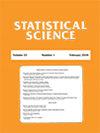现代变量选择在行动中——评HTT和BPV的论文
IF 3.4
1区 数学
Q1 STATISTICS & PROBABILITY
引用次数: 2
摘要
首先,让我祝贺这两篇论文(以下简称HTT和BPV)的作者,他们在高维回归中变量选择问题的方法比较方面做出了卓越的贡献。所考虑的方法确实是当今应对当前如此重要的大数据问题的规模和复杂性的主要竞争者。毫不奇怪,这里没有明确的赢家,因为比较的领域是如此广阔和复杂,没有一种单一的方法可以在所有情况下占据主导地位。所考虑的设置在观测次数n、预测因子数量p、潜在非零回归系数的数量和相对大小、预测因子相关性结构和信噪比(SNR)方面变化很大。即使是这些也只是触及了无限可能性的表面。此外,还有一个额外的问题,即哪种绩效衡量标准最重要。分析的目标是精确的变量选择还是预测,或者两者兼而有之?那么计算速度和可扩展性又如何呢?所有这些考虑自然取决于手头的实际应用。HTT和BPV所比较的方法是由计算速度的非凡发展释放出来的,因此主要通过它们新颖的实现算法来区分它们是很有吸引力的。特别地,最近用于变量选择的整数优化相关算法在基本方面与现在广泛采用的用于套索相关方法的坐标上升算法不同。毫无疑问,这些算法在计算速度上的显著提高对实际应用的可行性至关重要。然而,性能差异背后更根本的故事与他们的算法寻求优化的标准之间的差异有关。从一个重要的意义上说,他们受到一般变量选择问题的不同解决方案的指导。首先关注HTT的论文,它的主要推动力似乎是由Bertsimas、King和Mazumder(2016)(以下简称BKM)的计算突破点燃的,他们提出了一种混合整数光学-本文章由计算机程序翻译,如有差异,请以英文原文为准。
Modern Variable Selection in Action: Comment on the Papers by HTT and BPV
Let me begin by congratulating the authors of these two papers, hereafter HTT and BPV, for their superb contributions to the comparisons of methods for variable selection problems in high dimensional regression. The methods considered are truly some of today’s leading contenders for coping with the size and complexity of big data problems of so much current importance. Not surprisingly, there is no clear winner here because the terrain of comparisons is so vast and complex, and no single method can dominate across all situations. The considered setups vary greatly in terms of the number of observations n, the number of predictors p, the number and relative sizes of the underlying nonzero regression coefficients, predictor correlation structures and signal-to-noise ratios (SNRs). And even these only scratch the surface of the infinite possibilities. Further, there is the additional issue as to which performance measure is most important. Is the goal of an analysis exact variable selection or prediction or both? And what about computational speed and scalability? All these considerations would naturally depend on the practical application at hand. The methods compared by HTT and BPV have been unleashed by extraordinary developments in computational speed, and so it is tempting to distinguish them primarily by their novel implementation algorithms. In particular, the recent integer optimization related algorithms for variable selection differ in fundamental ways from the now widely adopted coordinate ascent algorithms for the lasso related methods. Undoubtedly, the impressive improvements in computational speed unleashed by these algorithms are critical for the feasibility of practical applications. However, the more fundamental story behind the performance differences has to do with the differences between the criteria that their algorithms are seeking to optimize. In an important sense, they are being guided by different solutions to the general variable selection problem. Focusing first on the paper of HTT, its main thrust appears to have been kindled by the computational breakthrough of Bertsimas, King and Mazumder (2016) (hereafter BKM), which had proposed a mixed integer opti-
求助全文
通过发布文献求助,成功后即可免费获取论文全文。
去求助
来源期刊

Statistical Science
数学-统计学与概率论
CiteScore
6.50
自引率
1.80%
发文量
40
审稿时长
>12 weeks
期刊介绍:
The central purpose of Statistical Science is to convey the richness, breadth and unity of the field by presenting the full range of contemporary statistical thought at a moderate technical level, accessible to the wide community of practitioners, researchers and students of statistics and probability.
 求助内容:
求助内容: 应助结果提醒方式:
应助结果提醒方式:


